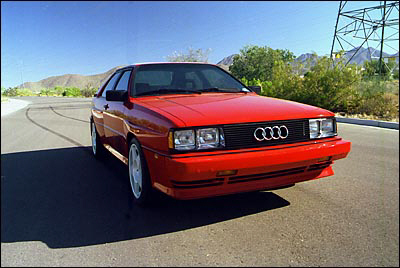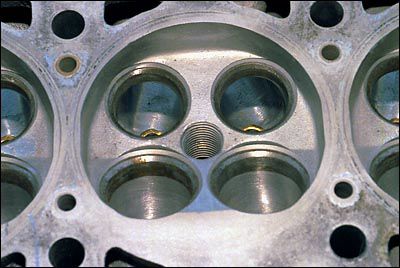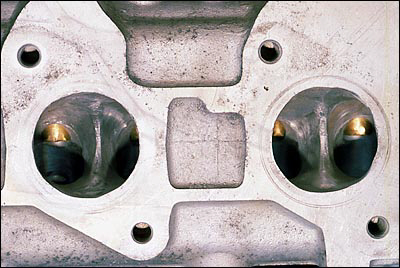 February 28,
2000 update: February 28,
2000 update:I realized this afternoon that not everybody knows what my '85 Ur-Q looks like and I probably should have included a photo of it with yesterday's update ... oh, well. Anyway, for the curious among you, here it is (and before you bring it up, Yes, I realize the 8x17 wheels aren't stock nor are the Koni strut inserts that I previously installed. Since I still have all of the original parts and both of these "mods" can be easily reversed, at the time, I figured they'd be okay. Besides, the car looks so much nicer with the 17" wheels that it'd almost be criminal not to use them...) A few interesting things: While shooting photos of parts for my upcoming eBay auctions, I took a closer look at the two extra heads that were included when I bought the '83 Ur-Q and V8 engine. Out of curiosity, I rummaged through my crates-o-parts and found the gasket set I bought to take with me to the '89 SCCA Solo II Nationals in case I had to tear down the engine of my '81 4000. I wasn't surprised to discover that except for a few coolant passages, which can be welded up and redrilled accordingly, the V8's head was a perfect match. In theory, this means that it should be possible to bolt a V8 head onto a 4-cylinder VW/Audi block without doing any major machine work. The corollary, of course, is that it should also be possible to bolt a pair of 16v VW heads onto a V8 block... Since the V8 head also has 16 valves, at first there may not appear to be any advantage to this. However, once you realize that the 16-valve VW engine put out 123 hp in U.S. trim and 139 hp in European trim (as compared to only 120 hp for one-half of a U.S.-spec V8 and 125 hp for half of a European-spec version) and that aftermarket cams are readily available for VW heads and effectively don't exist for the V8 (although rumor has it that ABT can still provide them at $2,700 (!) per set of four), the light should go on quickly.
I'm also investigating whether I can plug the front coolant outlets in the heads and use the rear ones that are usually used for the heater instead. If so, this'll give me a bit more room in front of the engine for the radiator/condenser/electric fan setup. I've also concluded the intake air for the engine doesn't necessarily have to come from the front of the car, as there's a high-pressure area at the base of the windshield and air could be drawn through the hood vents instead. Of course, if I ever end up adding turbos to it -- I must admit that I'm still fascinated by the idea -- all the intake plumbing would have to be revised again. For now, though, I think that doing it this way will make for a much cleaner, easier installation than trying to duct it in from the front of the engine compartmen to the backt.
By the way, the exhaust ports shown here are not standard; the previous owner was using this head to practice on and I don't think they were ever flow-tested. There appears to be a lot of variability between the shape of the ports so perhaps he was experimenting with different approaches ... I doubt I'll ever use these heads -- well, this one, anyway -- but I found it helpful to be able to poke and probe around them to get a feel for what Audi's designers tried to accomplish. For now, I'm content to leave them and the rest of the engine alone and instead focus on getting it installed and running. I know this project is starting to drag on (isn't this true of all the good ones?) but I don't want to rush anything and then have to spend even more time and money straightening it out later. |
 Although I haven't actually
confirmed it yet myself, I have it on good authority that the VW and V8 cams are different
enough that they can't be interchanged. Also, the 16-valve VW engine ran a 10.1:1 CR
versus the V8's 10.3:1, which suggests that maybe the VW head flows a little bit better
than the V8 head or possibly the VW's cams are ground a teeny bit more aggressively than
the V8's cams. Either way, if you're looking for more power out of a V8, swapping
to a pair of 16-valve VW heads may just be worth checking out further, despite the machine
work that will no doubt be required to handle the cam drive, etc.
Although I haven't actually
confirmed it yet myself, I have it on good authority that the VW and V8 cams are different
enough that they can't be interchanged. Also, the 16-valve VW engine ran a 10.1:1 CR
versus the V8's 10.3:1, which suggests that maybe the VW head flows a little bit better
than the V8 head or possibly the VW's cams are ground a teeny bit more aggressively than
the V8's cams. Either way, if you're looking for more power out of a V8, swapping
to a pair of 16-valve VW heads may just be worth checking out further, despite the machine
work that will no doubt be required to handle the cam drive, etc.  I have also begun to
explore the possibility of pushing the engine back by another inch or three, since this
will further increase the amount of room available between the front of the engine and the
nosepanel at the expense of increasing the angularity of the halfshafts. It's not
clear yet whether it will work or even if it's advisable (the one thing I'm definitely not
anxious to do is jeopardize the car's reliability) but if it's possible to gain even a few
silly millimeters, then I need to look into it.
I have also begun to
explore the possibility of pushing the engine back by another inch or three, since this
will further increase the amount of room available between the front of the engine and the
nosepanel at the expense of increasing the angularity of the halfshafts. It's not
clear yet whether it will work or even if it's advisable (the one thing I'm definitely not
anxious to do is jeopardize the car's reliability) but if it's possible to gain even a few
silly millimeters, then I need to look into it.